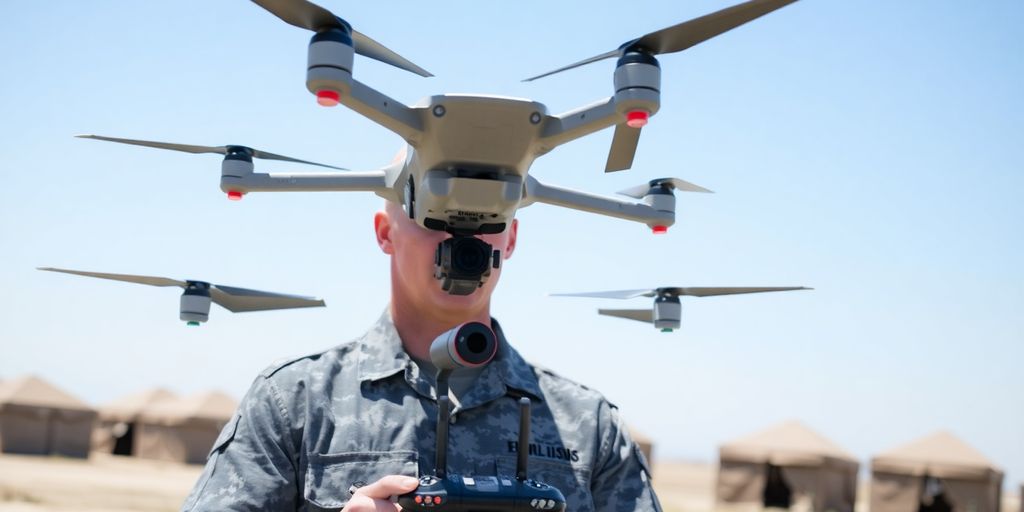Camp Pendleton Marines are intensifying their drone training to adapt to the evolving landscape of modern warfare. With technology advancing rapidly, the focus is on integrating offensive and defensive drone capabilities, including reconnaissance, attack, and counter-drone strategies, to prepare for future conflicts.
Marines Master Drone Warfare at Camp Pendleton
Marines at Camp Pendleton are undergoing intensive training to master the use of drones in both offensive and defensive capacities. This two-week drone integration course, led by the 1st Marine Division, emphasizes the critical role of unmanned aerial vehicles (UAVs) in contemporary combat scenarios. The training reflects a global shift in military tactics, heavily influenced by recent conflicts where drones have played a significant part.
Key Takeaways
- Marines are learning to expertly fly attack and reconnaissance drones.
- Training includes countering enemy drones using radar and jamming equipment.
- The course simulates real-world scenarios, such as defending a base against drone swarms.
- Emphasis is placed on integrating drone technology with traditional warfighting tools.
- The curriculum is constantly updated to keep pace with rapid advancements in drone capabilities.
Adapting to the Evolving Battlefield
Lt. Col. Nick Freeman, director of the division’s schools, highlighted the urgency of this training, citing the widespread use of drones in conflicts globally. The Marine Corps has established an attack drone team and is rapidly adjusting policies to facilitate this advanced training. The course features a round-robin setting, allowing Marines to familiarize themselves with various technologies before engaging in hands-on practice and simulated battle scenarios.
Comprehensive Training Modules
The training covers a wide array of skills essential for drone warfare:
- Offensive Operations: Utilizing drones for reconnaissance, target identification, and simulated attacks.
- Defensive Measures: Employing radar and electronic jamming systems to neutralize enemy drones.
- Tactical Integration: Learning how to combine drone capabilities with ground munitions and other traditional assets.
- Post-Engagement Protocols: Treating downed drones as unexploded devices for intelligence gathering, analyzing frequencies and potential payloads.
First Lt. Gannon Peifer, the course instructor, noted the dynamic nature of drone technology, stating that equipment can become outdated within a month. This rapid evolution necessitates a mindset of constant adaptation among the Marines. The course manual is updated monthly to reflect the latest developments.
Real-World Application and Future Implications
During a recent exercise, Marines practiced defending an area by taking offensive action against simulated enemy drone teams. This involved using dropper drones to strike targets and employing radio frequency detectors to identify and categorize incoming threats. Future exercises will incorporate live-fire ammunition.
Corporals Jacob Bennett and Nathan Baptiste, both from the 3rd Battalion/4th Marines, successfully completed a mission during the training. Bennett used a high-altitude drone for reconnaissance, spotting an enemy operator, and relaying the intelligence to Baptiste, who then used a lower-altitude attack drone to pinpoint the location for a simulated mortar strike. This collaborative effort underscores the integral role drones will play in future infantry operations.
Cpl. Christopher Magana Pinawin, an intelligence specialist, emphasized the growing prominence of drones and the importance of tactical knowledge in dealing with them. He plans to share his acquired skills with his unit and advocate for more Marines to receive this specialized training, ensuring broader preparedness within the corps.
Sources
- Camp Pendleton Marines do more training with drones as the technology advances – Orange County Register, Orange County Register.

Founder Dinis Guarda
IntelligentHQ Your New Business Network.
IntelligentHQ is a Business network and an expert source for finance, capital markets and intelligence for thousands of global business professionals, startups, and companies.
We exist at the point of intersection between technology, social media, finance and innovation.
IntelligentHQ leverages innovation and scale of social digital technology, analytics, news, and distribution to create an unparalleled, full digital medium and social business networks spectrum.
IntelligentHQ is working hard, to become a trusted, and indispensable source of business news and analytics, within financial services and its associated supply chains and ecosystems










